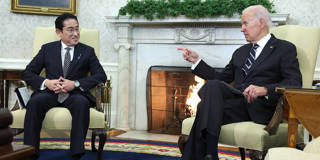In the face of the threats posed by China, Russia, and North Korea, Japan’s self-defense depends more than ever on the strength of its alliances. By significantly increasing its own defense spending and pursuing closer military cooperation with the United States, the current government is moving in the right direction.
CAMBRIDGE – Last December, Japanese Prime Minister Fumio Kishida announced the most ambitious expansion of military power in Japan since the creation of the country’s Self-Defense Forces in 1954. Japanese defense spending will rise to 2% of GDP – twice the 1% level that has prevailed since 1976 – and a new National Security Strategy lays out all the diplomatic, economic, technological, and military instruments that Japan will use to protect itself in the years ahead.

CAMBRIDGE – Last December, Japanese Prime Minister Fumio Kishida announced the most ambitious expansion of military power in Japan since the creation of the country’s Self-Defense Forces in 1954. Japanese defense spending will rise to 2% of GDP – twice the 1% level that has prevailed since 1976 – and a new National Security Strategy lays out all the diplomatic, economic, technological, and military instruments that Japan will use to protect itself in the years ahead.